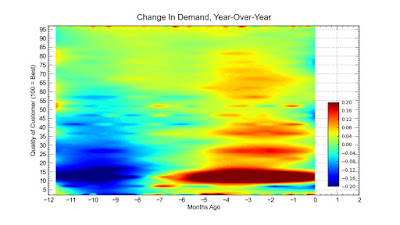Here's my catalog thesis, once again:
We will increase frequency. Your CFO will give you no choice.
Eventually, to prop up productivity, we will personalize the catalogs. Many catalogers won't.
By the way, your catalog vendors are going to LOVE THIS STRATEGY. They'll LOVE IT! They will make a ton of profit when you execute a personalized merchandise assortment.
- Housefile names are somewhat protected by increasing organic percentages.
- Acquisition name performance is not great, and is being impacted by a shortened "life of a catalog".
- Math dictates that we will have to mail smaller catalogs in response.
- Smaller catalogs generate less demand.
- We will have to mail smaller catalogs more frequently.
- Should the life of a catalog continue to erode, smaller catalogs will struggle to perform well, requiring us to personalize the merchandise assortment to each individual customer, based on customer history (both our history and recent co-op history).
- In response to these trends, catalogers are going to take one of four paths (more on this to follow).
What does it mean to "personalize the merchandise assortment"?
Let's go back to our example. We moved to a 64 page piece that became, once again, profitable. Then, the life of a catalog became shorter (again), reducing productivity by 10%.
- Demand per Book = $1.22.
- Profit Factor = 35%.
- Cost of Mailing = $0.45.
- Profit = ($0.02).
To combat this challenge, catalogers will move to a "personalized merchandise assortment". The catalog will get even smaller, and the merchandise in the catalog will focus only on the merchandise the customer wants to see.
This is common in e-commerce. There, home pages and landing pages are customized based on prior purchase data, prior visitation behavior, prior overlay data, and prior referring URLs. Companies employing these strategies enjoy conversion rates that are 20% to 50% greater than a "one size fits all" strategy.
Ok, let's move from a 64 page piece to a 36 page piece, a piece that features merchandise that a specific customer likes or will like. The 36 page piece could, in theory, be different for every customer ... a plug-and-play strategy. We lose some demand going from 64 pages down to 36 ... but we enjoy a 20% productivity gain because the merchandise assortment is relevant to the recipient. Our profit and loss statement now looks like this:
- Demand per Book = $1.16.
- Profit Factor = 35%.
- Cost of Mailing = $0.35.
- Profit = $0.06.
And once again, we've kept the wheels on the bus.
This is coming, friends. And it is a positive outcome. You get to keep doing what you love doing!!
Math is sending us down this path. Simple math. Not me, not you. Math.
We will greatly reduce pages. We have no choice.
We will increase frequency. Your CFO will give you no choice.
Eventually, to prop up productivity, we will personalize the catalogs. Many catalogers won't.
By the way, your catalog vendors are going to LOVE THIS STRATEGY. They'll LOVE IT! They will make a ton of profit when you execute a personalized merchandise assortment.
Next week, I will share with you how all of this shakes out. There are four paths that catalogers will take, in response to the math outlined this week.




























